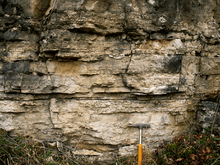Gogolin Formation
| System | Series | Stage | Age (Ma) | European lithostratigraphy |
|---|---|---|---|---|
| Jurassic | Lower | Hettangian | younger | Lias |
| Triassic | Upper | Rhaetian | 199.6–203.6 | |
| Keuper | ||||
| Norian | 203.6–216.5 | |||
| Carnian | 216.5–228.7 | |||
| Middle | Ladinian | 228.7–237.0 | ||
| Muschelkalk | ||||
| Anisian | 237.0–245.9 | |||
| Bunter or Buntsandstein | ||||
| Lower | Olenekian | 245.9–249.5 | ||
| Induan | 249.5–251.0 | |||
| Permian | Lopingian | Changhsingian | older | |
| Zechstein | ||||
| Major lithostratigraphic units of northwest Europe with the ICS's geologic timescale of the Triassic.[1] | ||||
Gogolin Formation - Triassic geologic formation, hitherto named the Gogolin Beds,[2][3] is the lowermost lithostratigraphical unit of the Lower Muschelkalk in the Silesian-Cracow Upland (S Poland, Central Europe), underlain by the Upper Buntsandstein (Lower Triassic) carbonates and overlain by the Górażdże Formation (Middle Triassic) carbonates.[4][5]
Name
Historical name coming from Gogolin, a small town in south Poland, where the Gogolin Formation was described for the first time, and where the main stratotypes have been exposed (see section Stratotypes).[4]
| Gogolin | |
|---|---|
| Town | |
 Gogolin | |
| Coordinates: 50°29′N 18°02′E / 50.483°N 18.033°E | |
| Country | Poland |
| Voivodeship | Opole |
| County | Krapkowice |
| Gmina | Gogolin |
Age
The Late Olenekian or Early Aegean (Anisian) to Pelsonian (Anisian),.[6][7]
Rocks
The formation is built of various carbonates which were deposited on a carbonate ramp.[4][8]

Subdivision
This Formation has recently been divided into four members, six beds, and two horizons:[4][5]
- Zakrzów Crinoidal Limestone Member, which includes: a) Krapkowice Pelitic Limestone Bed - thin-bedded, wavy bedded and marly micritic limestones, b) Dąbrówka Bioclastic Limestone Bed - thick- to medium-bedded, cross-bedded crinoidal limestones, c) Podbór Bioclastic Limestone Bed - thin- to medium-bedded, graded, horizontally and cross-bedded bioclastic limestones and wavy-bedded micritic limestones;
- The Skała Marl Member - marls interbedded with micritic and bioclastic limestones; the lowermost part of this member is locally built of broken-up limestone beds and lumps which are covered by an intraformational conglomerate with small intraclasts - they are divided as Kocina Intraformational Conglomerate Bed;
- The Emilówka Cellular Limestone Member, which includes: a) Karłubiec Bioclastic Limestone Bed - massive, cross-bedded, thin- to medium-bedded bioclastic and micritic limestones, b) Otmęt Marly Limestone Bed - strongly porous, thin-bedded marly limestones that are, in fact, dedolomitized dolomites;
- Odrowąż marly limestone horizon - marls, thin- to medium-bedded, graded, cross-bedded and horizontally bedded bioclastic limestones and thin layers of platy and wavy bedded micritic limestones;
- Malnia limestone horizon - thin- to medium-bedded, graded, horizontally and cross-bedded bioclastic limestones, thin-bedded, platy and wavy-bedded micritic limestones;
- Ligota Hill Wavy-Bedded Limestone Member - wavy-bedded and crumpled micritic limestones intercalated with medium- to thin-bedded, graded,cross- and horizontally bedded, bioclastic limestones.
Stratotypes
Stratotypes are located at Gogolin and its vicinity, Błotnica Strzelecka and Ligota Dolna (southern Poland).[4][5]
References
- ↑ Gradstein, F.M.; Ogg, J.G.; Smith, A.G. (2005), A Geologic Time Scale 2004, Cambridge University Press, ISBN 9780521786737
- ↑ Assmann P., 1913 - Beitrag zur Kenntniss der Stratigraphie des oberschlesischen Muschelkalks. Jb. Preuss. Geol. Landesanst., 34: 658 - 671, Berlin.
- ↑ Assmann P., 1944. Die Stratigraphie der oberschlesischen Trias. Teil 2: Der Muschelkalk. Abhandlungen des Reichsamtes für Bodenforschung, Neue Folge, 208: 1–124
- 1 2 3 4 5 Kowal-Linka M. 2008. Formalizacja litostratygrafii formacji gogolińskiej (trias środkowy) na Śląsku Opolskim. Geologos 14 (2): 125–161,
- 1 2 3 Kowal-Linka, M (2009). "Nowe jednostki litostratygraficzne w randze warstw w obrębie formacji gogolińskiej (trias środkowy) na Śląsku Opolskim". Geologia. 35 (2): 153–174.
- ↑ Nawrocki, J.; Szulc, J. (2000). "The Middle Triassic magnetostratigraphy from the Peri-Tethys basin in Poland". Earth and Planetary Science Letters. 182: 77–92. doi:10.1016/s0012-821x(00)00230-2.
- ↑ Zawidzka, K (1975). "Conodont stratigraphy and sedimentary environment of the Muschelkalk in Upper Silesia". Acta Geologica Polonica. 25: 217–256.
- ↑ Kowal-Linka, M., Stawikowski, W., 2013. Garnet and tourmaline as provenance indicators of terrigenous material in epicontinental carbonates (Middle Triassic, S Poland), 291: 27–47
Literature
- Assmann P., 1913 - Beitrag zur Kenntniss der Stratigraphie des oberschlesischen Muschelkalks. Jb. Preuss. Geol. Landesanst., 34: 658 - 671, Berlin.
- Assmann P., 1944. Die Stratigraphie der oberschlesischen Trias. Teil 2: Der Muschelkalk. Abhandlungen des Reichsamtes für Bodenforschung, Neue Folge, 208: 1–124.
- Kowal-Linka M. 2008. Formalizacja litostratygrafii formacji gogolińskiej (trias środkowy) na Śląsku Opolskim. Geologos 14 (2): 125–161 (and the references; the paper in Polish with English summary).
- Kowal-Linka M. 2009. Nowe jednostki litostratygraficzne w randze warstw w obrębie formacji gogolińskiej (trias środkowy) na Śląsku Opolskim. Geologia 35 (2): 153-174 (and the references; the paper in Polish with English summary).
- Kowal-Linka, M., Stawikowski, W., 2013. Garnet and tourmaline as provenance indicators of terrigenous material in epicontinental carbonates (Middle Triassic, S Poland), 291: 27–47.
- Nawrocki, J.; Szulc, J. (2000). "The Middle Triassic magnetostratigraphy from the Peri-Tethys basin in Poland". Earth and Planetary Science Letters. 182: 77–92. doi:10.1016/s0012-821x(00)00230-2.
- Niedźwiedzki R., 2000: Litostratygrafia formacji górażdżańskiej i formacji dziewkowickiej na Śląsku Opolskim. Prace Geologiczno-Mineralogiczne, 71, 1–72 (and the references; the paper in Polish with English summary).
- Zawidzka, K (1975). "Conodont stratigraphy and sedimentary environment of the Muschelkalk in Upper Silesia". Acta Geologica Polonica. 25: 217–256.
External links
- http://www.geologos.com.pl/archive.php?issue=11
- http://journals.bg.agh.edu.pl/GEOLOGIA/index.php?vol=2009-02
- "Garnet and tourmaline as provenance indicators of terrigenous material in epicontinental carbonates (Middle Triassic, S Poland)". Sedimentary Geology. 291: 27–47. doi:10.1016/j.sedgeo.2013.03.005.